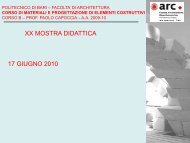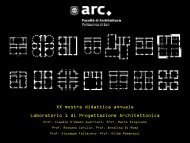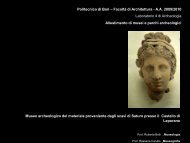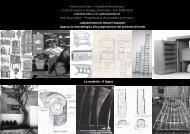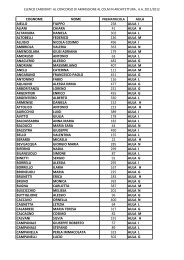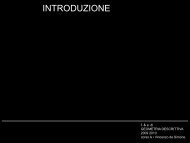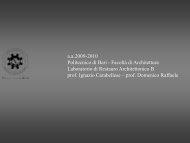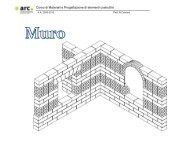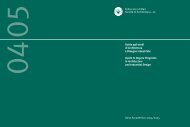44. I regolamenti <strong>di</strong>dattici110– the role of the mosque in the urban contextThe Model of the Arab Mosque– the Umayyad: agora and bas<strong>il</strong>ica: theinvention of the type– the Great Mosque in Damascus, the Cordovamosque– repeated spatial models and bu<strong>il</strong><strong>di</strong>ngtechniques of the hypostyle mosqueThe special features of the hypostyle mosque– the Fatimids: the T plan and the nine-domeplan– towards a greater organicity – the Qa’aMameluk mosque– the Great Mosque in Kairouan, Soussemosque, Ibn Tulun mosque in Cairo, al-Azharmosque, al-Hakim mosque, al-Juyushimosque, al-Aqmar mosque in CairoExercise 1: Examples of InterpretationThe model of the Persian mosque– from the hypostyle hall to the 4-iwan plan– spatial models and bu<strong>il</strong><strong>di</strong>ng techniques ofthe iwan mosque– the Friday mosque at IsfahanThe special features of the iwan mosque– the Timurids and Safavids: the 4-iwanmosqueExercise 2: Recognizing Mosques– the Selgiuqids: from the serial plan to agreater organicity– spatial models and bu<strong>il</strong><strong>di</strong>ng techniques ofthe Turkish mosqueThe mosques of Sinan– return to the organism of the central plan:the Ottomans and the legacy of Haya Sophia– spatial models and bu<strong>il</strong><strong>di</strong>ng techniquesExercise 3: The Islamic Garden– three derivations: the Arab hortusconclusus, the Persian bāgh-i bihisht and theTurkish temporary garden– spatial models and hydraulic techniquesCorso E/ Giampaolo ConsoliTema monografico: La Scuola <strong>di</strong> Roma:Architettura in Italia 1780-1820. Dallasperimentazione nel <strong>di</strong>segno alla praticadell’architettura civ<strong>il</strong>e.Case study: The Rome School. Architecture inItaly 1780-1820. From Design Experimentationto the Practice of ArchitecturesArgomenti delle lezioniIl corso svolgerà in maniera approfon<strong>di</strong>tal’analisi della formazione degli architettineoclassici nella Roma della fine del 700 e laloro successiva opera in Italia. Si vuolericostruire un momento storico particolareche ha portato alla creazione <strong>di</strong> un nuovolinguaggio, <strong>di</strong> nuove idee per la città e <strong>di</strong>nuovi tipi ed<strong>il</strong>izi.A partire da Roma e dall’esperienzafondamentale dell’accademia <strong>di</strong> S.Luca comeluogo <strong>di</strong> formazione comune, si tratteranno le<strong>di</strong>verse esperienze <strong>di</strong> architetti come Antolinie Pistocchi a M<strong>il</strong>ano e Faenza, Cambray Dignye Poccianti in Toscana, Vala<strong>di</strong>er, Camporesi eStern a Roma, Barabino a Genova, Bonsignorea Torino, Selva e Trezza nel Veneto, Aleandrinelle Marche ecc.In pratica si presenteranno i materiali ed <strong>il</strong>lavoro che porteranno nell’autunno allarealizzazione <strong>di</strong> una mostra pressol’accademia <strong>di</strong> S.Luca sugli stessi temiAll’interno <strong>di</strong> questo quadro generale ognistudente dovrà stu<strong>di</strong>are un singolo progettoper arrivare ad una sua ricostruzione ideale dainserire eventualmente in mostra.TopicsThe course w<strong>il</strong>l deal with the in-depth analysisof the education of neo-classical architects inRome at the end of the 1700’s and theirsuccessive works in Italy. The intention is thatof reconstructing the particular historicalperiod that led to the creation of a newlanguage, of new ideas for the city and newbu<strong>il</strong><strong>di</strong>ng types.Beginning with Rome and the fundamentalexperience of the Academy of St. Luca as thecommon site of education, the course w<strong>il</strong>llook at the <strong>di</strong>fferent experiences of architectssuch as Antolini and Pistocchi in M<strong>il</strong>an andFaenza, Cambray Digny and Poccianti inTuscany, Vala<strong>di</strong>er, Camporesi and Stern inRome, Barabino in Genoa, Bonsignore inTurin, Selva and Trezza in Veneto, Aleandri inthe Marche, etc.The course w<strong>il</strong>l present the material and theworks that w<strong>il</strong>l lead, during the autumn, to therealisation of an exhibition at the Academy ofSt. Luca dealing with the same themes.As part of this general framework, eachstudent must study a single project in order toarrive at an ideal reconstruction for eventualexhibition.Corso F/ Clau<strong>di</strong>o D’AmatoTema monografico: L’altra modernitàCase study:The other modernityArgomenti delle lezioni1. Lo st<strong>il</strong>e- Roma antica moderna: continuità dellatra<strong>di</strong>zione classica e rinnovamento delle arti.L’esposizione universale <strong>di</strong> Roma, 1942 (EUR)- St<strong>il</strong>e <strong>di</strong> Armando Brasini- St<strong>il</strong>e <strong>di</strong> Florestano <strong>di</strong> Fausto: esercizi <strong>di</strong> st<strong>il</strong>enel Dodecanneso italiano; la costruzione <strong>di</strong>Tirana moderna; modernità d’esportazione: <strong>il</strong>laboratorio libico.- Laboratori della modernità fra tra<strong>di</strong>zione einnovazione: la Scuola <strong>di</strong> Roma e la figura <strong>di</strong>Giovanni Battista M<strong>il</strong>ani; Marcello Piacentini <strong>il</strong>grande me<strong>di</strong>atore; tre laboratori romani: <strong>il</strong>foro Mussolini, la Città Universitaria, l’E42.- St<strong>il</strong>e <strong>di</strong> Saverio Dioguar<strong>di</strong>- St<strong>il</strong>e <strong>di</strong> Concezio Petrucci- St<strong>il</strong>e <strong>di</strong> Gaetano Minnucci- Misura italiana e identità europea:l’esperienza artistica in Italia tra le due guerre;<strong>il</strong> ritorno all’or<strong>di</strong>ne; la misura italiana comepunto <strong>di</strong> equ<strong>il</strong>ibrio e <strong>di</strong> salvezza per l’ identitàeuropea.2. Città <strong>di</strong> fondazione- Teorie e modelli delle ‘città nuove’ degli anniTrenta: <strong>il</strong> contributo <strong>di</strong> Concezio Petrucci- Teorie e modelli delle ‘città nuove’ degli anniTrenta: le città pontine: Littoria-LatinaSabau<strong>di</strong>a Pomezia- Dodecaneso: i progetti italiani per Ro<strong>di</strong>, Cooe Portolago- Albania: Tirana 1925 – 1943- Libia: V<strong>il</strong>laggi in Cirenaica3. La città e <strong>il</strong> mare- Amate sponde: <strong>il</strong> Me<strong>di</strong>terraneo; <strong>il</strong> mondo deicrinali; l’ere<strong>di</strong>tà <strong>di</strong> Roma.- Egitto: Alessandria e <strong>il</strong> suo fronte a mare- Puglia: Il lungomare Nazario Sauro a <strong>Bari</strong>- Puglia: Il lungomare Vittorio Emanuele III aTaranto- Calabria: Il fronte a mare <strong>di</strong> Reggio Calabria- Sic<strong>il</strong>ia: Il fronte a mare <strong>di</strong> MessinaTopics1. The style
- Ancient modern Rome: the continuity ofclassical tra<strong>di</strong>tion and the renewal of the arts.The Esposizione Universale <strong>di</strong> Roma[Universal Exhibition of Rome], or E42 <strong>di</strong>strict.- Style of Armando Brasini.- Style of Florestano <strong>di</strong> Fausto in Dodecaneseislands, Albania, Libya.- Laboratories of modernity between tra<strong>di</strong>tionand innovation: The Rome School and thefigure of Giovanni Battista M<strong>il</strong>ani; MarcelloPiacentini, the Great Me<strong>di</strong>ator; three Romanworkshops: the Foro Mussolini, the CittàUniversitaria, and E42.- Style of Saverio Dioguar<strong>di</strong>- Style of Concezio Petrucci- Style of Gaetano Minnucci- Italian measure and European identity: theItalian art between the two world wars, the“return to order”; the Italian measure as thesalvation of the European civ<strong>il</strong>ization.2. Planned cities- Theories and models for the ‘new towns’ inthe 1930s: the experience of ConcezioPetrucci- Theories and models for the ‘new towns’ inthe 1930s: Littoria-Latina, Sabau<strong>di</strong>a, Pomezia.- Dodecanese islands: Italian urban andarchitectural designs for Ro<strong>di</strong>, Coo ePortolago- Albania: Tirana 1925 – 1943- Libya: v<strong>il</strong>lages of the Italian colonization inCyrenaica.3. The city and the sea- Beloved shores: the Me<strong>di</strong>terranean sea, theworld of ridges, the heritage of Rome.- Egypt: Alexandria and its seafront.- Apulia: <strong>Bari</strong> and its seafront- Apulia: Taranto and its seafront- Calabria: Reggio Calabria and its seafront- Sic<strong>il</strong>y: Messina and its seafrontIscrizione al corsoLe iscrizioni avvengono obbligatoriamentesulla piattaforma entro i primi <strong>di</strong>eci giornidall’inizio delle lezioni.Modalità d’esamePer sostenere l’esame lo studente deveessere regolarmente iscritto al 4° anno (incorso o fuori corso): è necessaria lafrequenza dei moduli per i quali si èeffettuata l’opzione; tale frequenza verràr<strong>il</strong>evata nei mo<strong>di</strong> e nelle forme in<strong>di</strong>cate daldocente. In sede <strong>di</strong> esame sarà valutata laconoscenza e la capacità <strong>di</strong> valutazionestorico-critica della materia.Laboratorio <strong>di</strong> Restauro architettonicoArchitectural restoration design stu<strong>di</strong>oIcar 19-10,5 cfu4° anno / corso annualeArea <strong>di</strong>dattica III:Teoria e tecniche per <strong>il</strong> restauroarchitettonico• Restauro architettonico (Icar 19-7,5 cfu)••Teorie e tecniche costruttive nel lorosv<strong>il</strong>uppo storico (Icar 09-3 cfu)Corso A• Rossella De Cad<strong>il</strong>hac•• Giosi UvaCorso B• Ignazio Carabellese•• Domenico RaffaeleCorso C• Giacomo Martines•• Rita GrecoFinalità e contenuti <strong>di</strong>sciplinariIl Laboratorio <strong>di</strong> restauro è finalizzato afornire gli strumenti metodologici necessariad affrontare le problematiche proprie delrestauro dell’architettura, <strong>il</strong> cui progetto èimprescin<strong>di</strong>b<strong>il</strong>e dalla conoscenza delmonumento (storica, strutturale,tecnologica, ecc.). In tal senso èfondamentale la fase <strong>di</strong> analisi, che trovanel r<strong>il</strong>ievo del manufatto <strong>il</strong> presupposto <strong>di</strong>ogni ulteriore indagine.L’intervento progettuale, che segue la fase<strong>di</strong> analisi ed è funzionale alla valorizzazionee alla conservazione delle antichetestimonianze, non può prescindere dallaloro consistenza materiale e strutturale.Aims and contentsThe Restoration Stu<strong>di</strong>o is aimed atprovi<strong>di</strong>ng proper methodological tools forfacing the problems of ArchitecturalRestoration, whose project is strictlyrelated to the knowledge of the monument(from the historical, structural andtechnologic point of view). In this sense,fundamental is the moment of the analysis,which finds in the survey the necessarycon<strong>di</strong>tion for every further investigation.The applicative project which follows theanalysis phase is aimed at the conservationand protection of the historical significanceof monuments, but can not <strong>di</strong>sregard theirmaterial and structural foundation.Articolazione delle attività <strong>di</strong>datticheIl Laboratorio <strong>di</strong> restauro si articola in dueinsegnamenti le cui lezioni sono svolte informa coor<strong>di</strong>nata:- Restauro architettonico- Teorie e tecniche costruttive nel lorosv<strong>il</strong>uppo storico.Restauro architettonicoL’appren<strong>di</strong>mento teorico (sapere) è relativoalla conoscenza del manufatto nei suoi<strong>di</strong>versi aspetti, nonché alla definizione <strong>di</strong>una metodologia <strong>di</strong> intervento coerentecon i principi teorici orientati allaconservazione e alla restituzione dellaleggib<strong>il</strong>ità dell’immagine storica delmonumento.La componente applicativa (saper fare) èriconducib<strong>il</strong>e sia alla documentazione delmonumento nello stato attuale (r<strong>il</strong>ievo44.2.10 Progetti <strong>di</strong>dattici del II ciclo del CdLm in Architettura111
- Page 1:
0607Politecnico di BariFacoltà di
- Page 4 and 5:
Politecnico di Bari, Facoltà di Ar
- Page 6 and 7:
4. Regolamenti didattici4.1. Il Reg
- Page 8 and 9:
PresentazionePresentazioneLa Facolt
- Page 11 and 12:
Le strutture didattiche e di suppor
- Page 13 and 14:
giorno e dando, quindi, esecutivit
- Page 15 and 16:
• esprimere pareri sui compiti di
- Page 17 and 18:
1.3. La Biblioteca di FacoltàIl pa
- Page 19 and 20:
2. Strutture di ricerca e di suppor
- Page 21 and 22:
BIO 07, Ecologia43 Mariavaleria Min
- Page 23 and 24:
le richieste e le iniziative ad ess
- Page 25:
2.3 Le biblioteche d’area2.3.1 Le
- Page 28 and 29:
33. La didattica e gli studenti263.
- Page 31 and 32:
4. I Regolamenti didattici4.1. Rego
- Page 33 and 34:
presente regolamento;• le propede
- Page 35 and 36:
discussi ed i voti finali.Per ciasc
- Page 37 and 38:
4.2.4 Definizione delle aree discip
- Page 39 and 40:
laurea da attivare in base al numer
- Page 41 and 42:
non venga superato l’iscrizione a
- Page 43 and 44:
Manifesto del CdLs in Architettura
- Page 45 and 46:
Manifesto del CdLm in Architettura
- Page 47 and 48:
ciclo provenendo da altri Atenei.È
- Page 49 and 50:
Manifesto del CdLs in Architettura
- Page 51 and 52:
Manifesto del CdLm in Architettura
- Page 53 and 54:
Insegnamenti ssd Crediti Laboratori
- Page 55 and 56:
Insegnamenti ssd Crediti Laboratori
- Page 57 and 58:
Insegnamenti attivati e docenti per
- Page 59 and 60:
Insegnamenti attivati e docenti per
- Page 61 and 62: Finalità e contenuti disciplinariN
- Page 63 and 64: Lezioni- L’architettura etrusca e
- Page 65 and 66: ibliografiche, volte ad acquisire g
- Page 67 and 68: Discipline tecnologiche per l’Arc
- Page 69 and 70: Istituzioni di geometria I + Istitu
- Page 71 and 72: architettonicoTopicsLife drawing, u
- Page 73 and 74: • Representation of the shadows
- Page 75 and 76: frequenza del corso che consentel
- Page 77 and 78: capacità di valutazione storico-cr
- Page 79 and 80: scale edilizie e tra diversi tipi;
- Page 81 and 82: planning of Roman suburban andcount
- Page 83 and 84: mutation through the works of the p
- Page 85 and 86: -Equazioni indefinite di equilibrio
- Page 87 and 88: coerenza tra qualità funzionale, c
- Page 89 and 90: transformations (psychrometry).In t
- Page 91 and 92: madrepatria.4. La colonizzazione e
- Page 93 and 94: EtruscologiaEtruscologyL-ANT/07 - 4
- Page 95 and 96: Archeologia e Storia dell’Arte Ro
- Page 97 and 98: The student will develope the archi
- Page 99 and 100: tanto il rapporto tra elementi, str
- Page 101 and 102: sociale dell’abitare (Loos, Tesse
- Page 103 and 104: experimental research into the beha
- Page 105 and 106: Articolazione dell’attività dida
- Page 107 and 108: Aims and contentsThe Urban Sociolog
- Page 109 and 110: nell’ambito dell’annuale “mos
- Page 111: di laurea. Sarà quindi necessario
- Page 115 and 116: During the lessons, theoretical and
- Page 117 and 118: Le esercitazioni costituiscono lo s
- Page 119 and 120: typological and technical innovatio
- Page 121 and 122: • la fenomeni di propagazione del
- Page 123 and 124: Aims and contentsThe urban economy,
- Page 125 and 126: value of a civil apartment with the
- Page 127 and 128: l’elaborazione della tesi di rice
- Page 129 and 130: 4.3.8 Esame di laureaPer essere amm
- Page 131 and 132: semestrale• Laboratori di sintesi
- Page 133 and 134: 4.3.14 Manifesto del CdL in Disegno
- Page 135 and 136: 4.3.16 Organizzazione delle attivit
- Page 137 and 138: 4.3.17 Insegnamenti e docenti per a
- Page 139 and 140: Laboratorio di Disegno industriale
- Page 141 and 142: • metodo dell’assonometria;•
- Page 143 and 144: fine dell’Ottocento; le avanguard
- Page 145 and 146: Iscrizione al corsoLe iscrizioni av
- Page 147 and 148: Laboratorio di Arredamento 2/IInter
- Page 149 and 150: Disegno 2/IIDrawing 2/IIIcar 17-5 c
- Page 151 and 152: communication, as follows:• typog
- Page 153 and 154: 4.3.22 Progetti didattici3° anno
- Page 155 and 156: sintetiche, segnaletica interna ed
- Page 157: esercitazioni pratiche, attività d
- Page 160 and 161: 55. Relazioni internazionali1585.1
- Page 163 and 164:
6. Post Lauream6.1. Dottorato di Ri
- Page 165 and 166:
Attività di ricercaLo svolgimento
- Page 167 and 168:
particolari e specifiche competenze
- Page 169 and 170:
iscrizione all’esame di ammission
- Page 171 and 172:
scientifico-disciplinare in cui è
- Page 173:
• alla sicurezza statica (corrett
- Page 176 and 177:
a.1 Planimetria del campus epiante
- Page 178 and 179:
Status accademico dei docentiDocent
- Page 180 and 181:
aAppendici178A.3 Indice dei nomiAAc
- Page 182 and 183:
aAppendicia.5 Calendario annuale de




